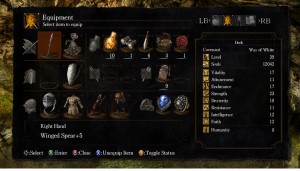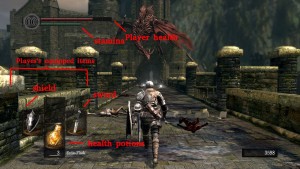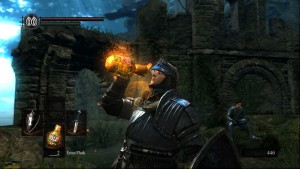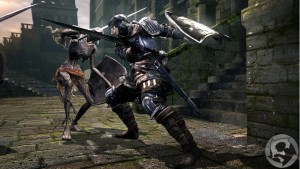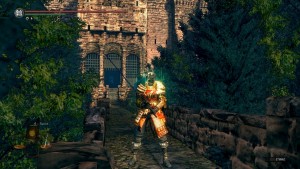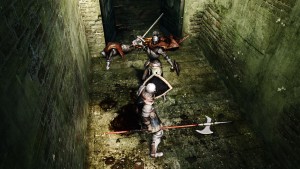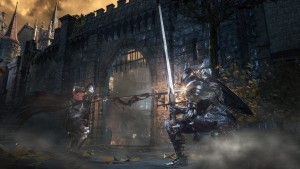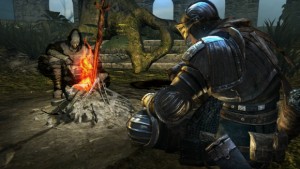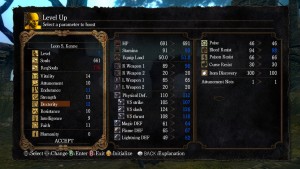In Dark Souls, the non-player characters (NPCs) effect an element of gameplay not many other games have. What’s interesting about the NPCs in this game are that each one has a unique storyline only known by talking to the character throughout the game. Some only have dialogue options, some are merchants who sell various goods in different areas, and some will give the player access to important game items. The player can make various decisions or agreements with the NPCs when prompted, and this can effect the NPC’s storyline. Some will show up in future areas the player must work through and there will be a new dialogue or event that takes place.
For example, in an area very late in the game, an NPC will appear and sell goods to the player in this area only if the player has talked to the NPC previously and exhausted all his dialogue options. If the player arrives there and doesn’t see the NPC, he can backtrack and find where the NPC is and talk to him there so that he will appear in the new area. This is useful if the NPC sells unique goods; this one particularly sells spells so a sorcerer would find this NPC quest line to be very helpful! Others may not matter, and in fact, the player may not even encounter or speak to many NPCs without going out of his way. In addition, the NPCs do not often tell the player where they will be, so the only way of knowing is to talk to each NPC and gain as much information as possible, this is despite the fact that the online wiki for Dark Souls has all the information regarding every NPC quest line available.
Perhaps the most important type of NPC in the game though is the ones who can aid the player in boss battles! It’s important to note that every NPC in the game can be killed by the player!! Turning them hostile toward the player with every future encounter until the NPC has died or the player requests absolution from a very specific NPC, a priest, and pays a hefty price. This is especially important if the player recklessly goes around killing all NPCs—he may kill an important ally that would have aided in battle!
The process for gaining an ally in battle is not difficult but does require 3 things: first the player must acquire an item that allows “summoning” another player. This is called the white soapstone and it’s actually gifted to the player very early in the game by the second NPC encounter! It IS possible to miss this encounter if the player is not thorough, but it’s possible to backtrack or to purchase it from a future merchant for a low price.
Second, the NPC must be in the correct state in order to be summoned, that is, every NPC that can aid in battle must at least be found and spoken to first before he or she can even aid the player. Sometimes this can be tricky since as mentioned earlier, it’s possible to miss a lot of NPCs in the game due to them changing locations many times! With some, simply talking to them is not enough. For example, for the very first major boss battle there is an NPC who is found in the same room as before the boss, but he’s imprisoned behind bars. The player can talk to this NPC through the bars and is asked to free him. It’s possible to talk to him and NOT free him, but then he cannot aid the player in the boss battle. Only after freeing him and speaking to him once he is freed (in a different area) will this NPC then be available to be summoned for that boss battle. Also, each boss battle can only have 1 specific NPC summoned, so it is not at the player’s discretion to choose out of a pool of NPCs later in the game to decide who can aid in battle. This would be an amazing feature, but restricting which NPCs can help leads to the difficulty challenge to the game.
The last condition for the player to summon an NPC in a boss battle is that the player must be in a state of condition called “human”. This is completed at a bonfire, where there is an option to do so, but it does require an item called “humanity”. The player is often in a default state called “hollow” and reviving to human has many other benefits that will not be delved into in this guide, but it’s one condition necessary in order to summon an NPC.
If you’ve tried your hand at Dark Souls previously, or still want to, but are daunted by the infamously challenging gameplay, hopefully knowing that help is possible along the way will lessen the dread, as it is very worth attempting. Next we’ll be looking at aspects of online gameplay possible!
